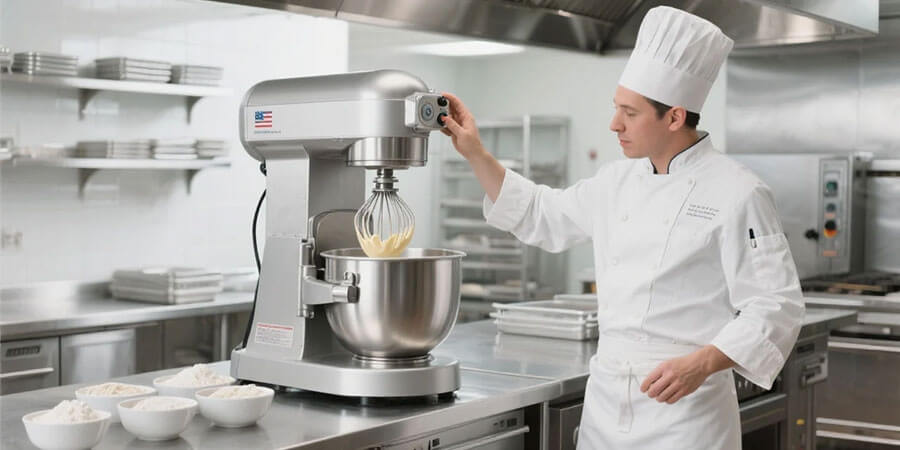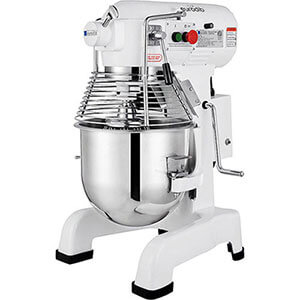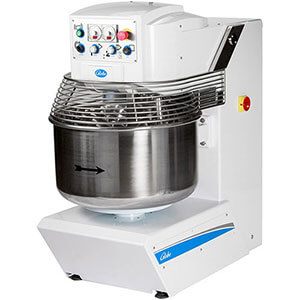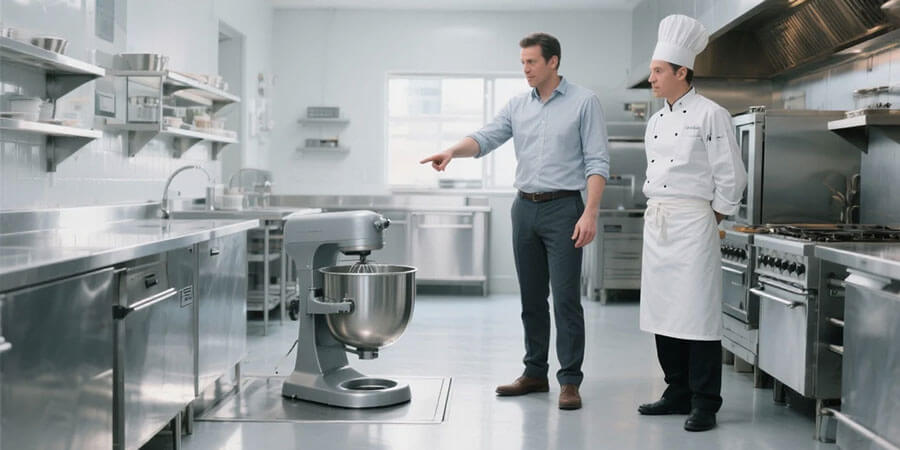Commercial Kitchen Mixing Equipment Guide

Table of Contents
Your complete guide to choosing commercial mixing equipment for restaurants
Choosing the right commercial mixing equipment can make or break your restaurant's efficiency. From planetary mixers for general baking to spiral mixers for heavy dough, this guide covers all the essential mixer types with specific recommendations for different restaurant sizes and cuisines.
Equipment Categories & Options
Planetary Mixers: The Restaurant Workhorse
Best For: General mixing, baking, batter preparation, whipping

Key Features to Look For:
- Bowl capacity (5-80 quarts)
- Variable speed control
- Timer functionality
- Multiple attachments (whisk, paddle, hook)
- Bowl-lift or tilt-head design
Planetary Mixers by Capacity:
| Capacity: | Best For: | Key Features: |
| 5-10 qt | Small cafes, prep areas | Compact size, easy storage, variable speed |
| 20-30 qt | Medium restaurants, bakeries | Versatile attachments, reliable performance |
| 40-60 qt | Large restaurants, high-volume | Heavy-duty construction, multiple attachments |
| 80+ qt | Industrial bakeries, chains | Maximum capacity, commercial-grade components |
Spiral Dough Mixers: Heavy-Duty Dough Preparation
Best For: Bread dough, pizza dough, heavy batters, sausage preparation

Key Features to Look For:
- Dough capacity (20-375 lbs)
- Two-speed operation
- Bowl and hook design
- Stainless steel construction
- Safety features
Spiral Mixers by Capacity:
| Capacity: | Best For: | Key Features: |
| 20-40 lbs | Small bakeries, pizza shops | Efficient for daily bread production, easy cleanup |
| 50-80 lbs | Medium bakeries, restaurants | Professional dough development, consistent results |
| 100-137 lbs | Large bakeries, pizzerias | High-volume production, heavy-duty construction |
| 200+ lbs | Industrial operations | Maximum capacity, continuous operation |
Mixer Attachments & Accessories
Essential Attachments for Planetary Mixers
Planetary mixers offer incredible versatility through their wide range of attachments. These accessories transform your mixer from a single-purpose tool into a multifunctional workhorse for your kitchen.
Wire Whip
The wire whip is essential for tasks that require incorporating air into mixtures. With its balloon-shaped wires, it creates maximum aeration for light, fluffy results. This attachment excels at whipping cream, egg whites, meringue, and other light batters where volume and lightness are crucial.
Flat Beater/Paddle
For heavy mixtures that don't require aeration, the flat beater is your go-to attachment. Its sturdy, flat design thoroughly mixes cookie dough, firm batters, and pie crust without incorporating unwanted air. This attachment is perfect for brownies, firm cookie dough, and any recipe where you want dense, well-combined results.
Dough Hook
The dough hook is specifically designed for yeast doughs and heavy bread preparations. Its spiral shape mimics the motion of hand kneading, providing the perfect amount of stretch and development for bread, rolls, pizza crust, and laminated doughs. This attachment ensures your dough develops the proper gluten structure without overworking it.
Pastry Knife/Blade
When you need to cut butter into flour or work with crumbly mixtures, the pastry knife attachment is invaluable. Unlike other attachments that mash ingredients, this sharp blade cuts cleanly through butter and flour, creating the perfect texture for shortbread, biscuits, pie crust, and streusel toppings.
Specialized Attachments & Accessories
Bowl Scraper
A bowl scraper attachment moves with the bowl during mixing, ensuring every bit of your ingredients gets incorporated. This not only reduces waste but also eliminates the need for manual scraping, saving time and maximizing your ingredient utilization in every batch.
Grater & Shredder Attachments
These attachments come with multiple discs in various sizes, allowing you to grate cheese, shred vegetables, and process fruits and chocolate with precision. From fine parmesan gratings to coarse vegetable shreds, these attachments handle a wide range of prep tasks that would otherwise require separate equipment.
Slicer Attachments
For uniform cutting of vegetables and fruits, slicer attachments provide consistent results every time. With various blade thicknesses available, you can achieve the perfect slice for pie fillings, salads, toppings, and other applications where uniformity matters.
Mixer Attachments Comparison Chart
| Attachment: | Best For: | Key Features: | Speed Setting: | Common Applications: |
| Wire Whip | Light, airy mixtures | Balloon-shaped wires for aeration | High speed | Whipped cream, meringue, light batters, frosting |
| Flat Beater | Heavy, dense mixtures | Flat paddle design, no aeration | Medium speed | Cookie dough, pie crust, firm batters, mashing |
| Dough Hook | Yeast doughs, heavy breads | Spiral shape mimics hand kneading | Low-medium speed | Bread dough, pizza dough, heavy yeast mixtures |
| Pastry Knife | Cutting fats into flour | Sharp blade for clean cuts | Low speed | Shortbread, biscuits, scones, streusel toppings |
| Bowl Scraper | Complete ingredient incorporation | Moves with bowl during mixing | N/A (passive) | All mixing tasks, waste reduction, efficiency |
| Grater/Shredder | Cheese, vegetables, fruits | Multiple disc sizes | Variable | Parmesan, vegetables, chocolate, garnishes |
| Slicer: | Uniform vegetable/fruit cutting | Various blade thicknesses | Variable | Salads, pie fillings, toppings, presentation |
Choosing the Right Attachments
Assess your menu and common preparation tasks to determine which attachments will get the most use in your operation. Always invest in durable, commercial-grade attachments that can withstand daily use. Ensure compatibility with your specific mixer model, and consider storage solutions that keep attachments clean and easily accessible.
Selection Decision Framework

Step 1: Assess Your Requirements
- Production Volume: Daily mixing requirements and peak periods
- Space Constraints: Counter space, storage, and ventilation needs
- Power Requirements: Available electrical capacity and phases
- Budget Parameters: Initial investment vs. long-term operating costs
- Menu Requirements: Types of dough, batters, and mixing applications
Step 2: Key Specifications to Evaluate
- Capacity: Match to your production needs with 25% buffer
- Power: Commercial-grade motors for continuous operation
- Construction: Stainless steel for durability and sanitation
- Controls: Intuitive operation for staff training
- Safety: Guards, locks, and emergency stops
Step 3: Compare Options Systematically
Small Operation Choice: 5-20 Quart Planetary
- Price Range: $800-$2,500
- Best For: Cafes, small restaurants, food trucks
- Key Advantages: Compact size, versatile attachments, affordable
- Considerations: Limited capacity for growth
Medium Operation Choice: 20-40 Quart Planetary
- Price Range: $2,500-$5,000
- Best For: Most independent restaurants
- Key Advantages: Balanced capacity and cost, professional performance
- Sweet Spot: Excellent value for growing operations
Large Operation Choice: 60+ Quart Planetary + Spiral
- Price Range: $8,000-$15,000+
- Best For: High-volume restaurants, bakeries, chains
- Key Advantages: Maximum capacity, heavy-duty construction
- Considerations: Higher upfront cost, larger footprint
Implementation & Setup
Installation Timeline
- Week 1: Site assessment and utility verification
- Week 2: Equipment delivery and uncrating
- Week 3: Professional installation and testing
- Week 4: Staff training and calibration
Power and Space Requirements
- Planetary Mixers: 15-30 amps, 20-40 sq ft space
- Spiral Mixers: 20-50 amps, 30-60 sq ft space
Maintenance & Care Schedule
Daily Maintenance
- Clean mixer exterior and attachments
- Check for unusual noises or vibrations
- Verify proper operation of controls
- Inspect power cords and connections
Weekly Maintenance
- Deep clean mixing bowl and attachments
- Lubricate moving parts as needed
- Check belt tension and alignment
- Calibrate speed and timer functions
Monthly/Quarterly Maintenance
- Professional servicing and inspection
- Replace worn belts and seals
- Clean internal components
- Performance testing and calibration
Annual Maintenance
- Complete teardown and inspection
- Replace consumable parts
- Update software/firmware
- Comprehensive performance audit
Cost Analysis & ROI

Purchase Cost Breakdown
- Entry-Level Equipment: Basic planetary mixer with attachments for small operations
- Mid-Range Equipment: Professional planetary mixer or spiral mixer for medium restaurants
- Premium Equipment: High-capacity planetary and spiral mixers for large operations
Operating Cost Analysis
- Energy Consumption: Varies by mixer type and usage - check manufacturer specifications
- Maintenance Costs: Annual service contracts and parts replacement costs
- Emergency Repairs: Budget for unexpected maintenance as needed
ROI Timeline
Break-Even Analysis: Varies by equipment cost and labor savings achieved
- Calculate based on your specific labor rates and usage requirements
- Consider both direct labor savings and improved consistency
- Factor in maintenance costs when projecting long-term savings
Recommendations by Restaurant Type

For Quick Service Restaurants (QSR)
Priority Needs: Speed, consistency, durability
- Top Pick: 20-quart planetary mixer - Reliable performance for fast-paced environments
- Runner-Up: 30-quart planetary mixer - Excellent build quality with good support
- Budget Option: 10-20 quart planetary mixer - Great value with solid performance
For Casual Dining Restaurants
Priority Needs: Flexibility, presentation quality
- Top Pick: 30-quart planetary mixer - Versatile attachments for varied menu
- Runner-Up: 20-quart planetary mixer with timer - Professional performance and reliability
- Budget Option: 20-30 quart planetary mixer - Good capacity for growing operations
For Fine Dining Restaurants
Priority Needs: Precision, consistency, premium features
- Top Pick: 60-quart planetary mixer - Industry standard for fine dining
- Runner-Up: 40-quart planetary mixer - Premium performance and reliability
- Budget Option: 30-40 quart planetary mixer - Excellent quality at reasonable price
For Bakeries & Pizza Shops
Priority Needs: Dough capacity, consistency, heavy-duty construction
- Top Pick: 60-80 lb spiral mixer - Perfect for bread and pizza dough
- Runner-Up: 40-60 lb spiral mixer - Excellent value for commercial baking
- Budget Option: 20-40 lb spiral mixer - Reliable performance for smaller operations
Equipment Recommendations by Mixer Type
Planetary Mixers
- Small Operations: 5-10 quart capacity - Compact and efficient for cafes and small kitchens
- Medium Operations: 20-30 quart capacity - Versatile workhorses for most restaurants
- Large Operations: 40-60 quart capacity - Heavy-duty performance for high-volume operations
Spiral Dough Mixers
- Small Bakeries: 20-40 lb capacity - Efficient for daily bread and pizza production
- Medium Bakeries: 50-80 lb capacity - Professional dough development for growing operations
- Large Operations: 100+ lb capacity - High-volume production for commercial bakeries
Frequently Asked Questions
What's the most important factor when choosing a commercial mixer?
Capacity is the most critical factor. Choose equipment that can handle your peak production with at least 25% buffer capacity. For restaurants, this means considering not just daily volume but also seasonal peaks and menu specials.
What's the difference between planetary and spiral mixers?
Planetary mixers rotate the mixing tool around the bowl while the bowl stays stationary, making them ideal for general mixing, whipping, and light dough. Spiral mixers use a spiral hook that mimics hand kneading, making them perfect for heavy bread dough, pizza dough, and tough batters.
How much should I budget for commercial mixing equipment?
Budget varies significantly by capacity and type. Small operations can expect to invest $1,000-$3,000, medium restaurants $3,000-$8,000, and large operations or bakeries $8,000-$20,000+. Consider both initial purchase and 5-year operating costs including energy, maintenance, and labor savings.
What's the typical lifespan of commercial mixers?
With proper maintenance, commercial mixers typically last 5-10 years. Entry-level equipment may need replacement after 3-5 years, while premium models can last 7-10 years with annual servicing and timely part replacement.
Do I need both planetary and spiral mixers?
It depends on your menu. Restaurants focused on baking, cakes, and general mixing can often get by with just a planetary mixer. Bakeries, pizzerias, and operations making heavy dough should invest in a spiral mixer. Many operations have both for maximum versatility.
What's the best commercial mixer brand for restaurants?
The best brand depends on your specific needs and budget. European manufacturers often provide excellent quality and innovative features, while North American brands typically offer reliable performance and strong dealer support. Consider factors like capacity requirements, warranty coverage, and local service availability when choosing a brand.
Can I use a commercial mixer for both sweet and savory applications?
Yes, commercial mixers are designed for versatility. Planetary mixers work well for cakes, batters, sauces, and whipped toppings. Spiral mixers excel at bread, pizza, and pasta dough. Just ensure proper cleaning between applications to prevent cross-contamination.
How do I calculate ROI for commercial mixing equipment?
Calculate ROI by comparing equipment cost against labor savings. Estimate how many hours of manual labor the mixer will eliminate daily, then multiply by your labor cost per hour. Subtract annual maintenance costs to get net savings. Divide net savings by equipment cost to determine annual ROI percentage.
Related Guides & Resources
Similar Equipment
- [Commercial Food Processors Guide] - Complete guide to food processing equipment
- [Commercial Slicers Guide] - Professional slicing equipment for restaurants
- [Commercial Grills Guide] - Cooking equipment selection and recommendations
Related Topics
- [Commercial Refrigeration Guide] - Cold storage solutions for restaurants
- [Commercial Dishwashers Guide] - Warewashing equipment for busy kitchens
- [Restaurant Kitchen Layout Guide] - Equipment placement and workflow optimization
Maintenance & Support
- [Commercial Equipment Maintenance] - Care and servicing schedules
- [Restaurant Equipment Troubleshooting] - Common issues and solutions
- [Commercial Warranty Guide] - Understanding equipment warranties
Shop Commercial Mixers
Browse our selection of commercial mixing equipment:
- [Planetary Mixers] - 70+ models from $800-$20,000
- [Spiral Dough Mixers] - 40+ models from $1,500-$15,000
Need help choosing? Contact our equipment specialists for personalized recommendations based on your menu and operation size.
Share This!